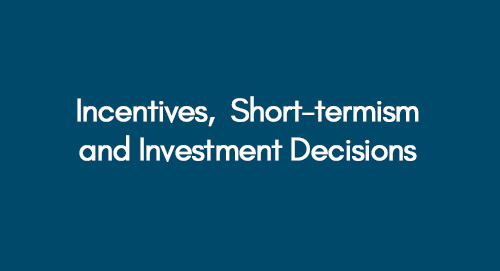
Marketing Innovation At Huel
January 16, 2021
Effect of Brand Love on the Consumer Buying Behaviour in the Dietary Supplement Sector
January 16, 2021Incentives wield influence on investment decisions, but the risk of short-termism necessitates a delicate balance in designing reward structures to avoid impeding long-term organizational prosperity. In the dynamic arena of corporate decision-making, the intricate dance among incentives, short-termism, and investment decisions plays a pivotal role in shaping the trajectory of organizations. The intricate web of motivations and time horizons within which executives operate can profoundly impact the strategic choices made at the helm. Navigating this complex landscape demands a keen awareness of the interplay between the allure of immediate rewards and the imperative of long-term organizational goals. As executives steer the ship of their companies through this intricate balance, the decisions they make not only influence their immediate success but cast a lasting shadow on the sustained health and growth of the organization.
Executives find themselves at the nexus of competing pressures, where the need for quick wins clashes with the imperative of long-term value creation. Balancing these demands requires a nuanced understanding of the risks and benefits associated with various incentive structures. Striking the right chord is not merely a theoretical challenge but a practical necessity for leaders seeking to guide their organizations through an ever-evolving business landscape. Ultimately, the decisions made at the crossroads of incentives, short-termism, and investment lay the groundwork for organisations' resilience and enduring success in the face of uncertainty and change.
Introduction
In recent years, there has been a notable surge in academic research focusing on the pivotal role of CEOs in shaping investment decisions within businesses. Carpenter et al. (2010) posit that CEOs serve as key decision-makers in investment-related matters, shouldering the responsibility of formulating corporate strategy, and are actively involved in fostering both short-term and long-term success for the company. Within the contemporary and highly competitive business landscape, incentive mechanisms emerge as a crucial element within the management control system, serving as a motivational factor in compensation contracts. According to Lin et al. (2011), a well-designed incentive scheme can significantly influence a CEO's decision-making processes, steering them toward actions that enhance the firm's performance and competitiveness.
Accounting and Finance in the Organisation
Various companies employ diverse measures to reward their Chief Executive Officers and employees, employing compensation schemes, incentives, and pay contracts. It is asserted that a positive correlation exists between incentive schemes and investment decisions, as these mechanisms are likely to sway CEOs towards making effective choices concerning investments. Ideally, CEOs are expected to engage in risk-taking for the benefit of the business. However, they often refrain from excessively imprudent and risky investment decisions. In light of this, the objective of the following essay is to scrutinize the design of incentive systems or compensation pay schemes, exploring how they should be structured to incentivize CEOs to make beneficial investment decisions without venturing into excessively risky territory for the business.
Analysis of Principal-Agent Problem and General Solution
The principal-agent problem in a business firm arises when an individual or entity has the authority to take actions or make decisions on behalf of the firm that can impact other entities or individuals. Gailmard (2012) explains that this problem typically occurs when an agent's incentives do not align with the principal's, where the principal must provide incentives to encourage the agent to act in line with their desires. The underlying assumptions of agency theory emphasize that the primary cause of the principal-agent problem is the misalignment of incentives with the goals and preferences of the manager or CEO, as agents are often motivated to act in their own best interests rather than those of their principal.
According to agency theory, the principal-agent relationship constitutes an organizational system where the agent represents the principal's interests while considering personal interests. However, due to inadequate incentive systems, agents may be inclined to prioritize their interests over those of the principal, posing a significant concern for many organizations. Forbes-Pitt (2011) adds that another assumption of agency theory contributing to the principal-agent problem is that agents rationally seek to maximize their material or financial returns, serving as a major driving force for actions driven by self-interest.
An additional assumption underlying the principal-agent problem is that the agent tends to reach equilibrium and possesses more information than the principal. Simultaneously, the principal is wary of potential exploitation by the agent, leading to a deviation from the agent's best interests and resulting in agency costs for the principal. Heineman and Davis (2011) highlight that the principal-agent problem is particularly prevalent between shareholders as principals and managers or CEOs as agents, significantly contributing to short-termism. The short-termism hypothesis posits that managers focus on achieving short-term goals at the expense of long-term profitability, leading to concerns about short-term stock prices.
Furthermore, Dallas (2011) notes that managers often prioritize short-term stock prices due to evaluating a firm's performance based on short-term stock prices, perpetuating short-termism within the organization. Antia, Pantzalis, and Park (2010) argue that short-termism negatively correlates with investment decisions, as CEOs prioritize short-term goals, ultimately diminishing the firm's performance and current stock prices. This inclination towards short-termism prevents CEOs from investing in substantial or risky projects that could yield long-term profits, resulting in excessively risky investment decisions.
Another key assumption contributing to the principal-agent problem is that managers are inherently risk-averse and may avoid highly risky projects with the potential for high profits. This misalignment of preferences between shareholders, who may prefer high-risk projects, and CEOs, who may lean towards low-risk and low-profitability projects, creates a conflict of interest. Many companies, including banks, financial institutions, car companies, and other business firms, are grappling with the principal-agent problem and actively seeking ways to address this issue. Establishing an effective contract design is the primary solution to resolve the principal-agent problem between shareholders and agents. This aims to address information asymmetry, align incentives and compensation for agents with the principal's best interests, and implement monitoring procedures to regulate their actions.
Analysis of Challenges in Compensation Pay Schemes and Investment Behaviour
In recent literature, a controversial hypothesis has emerged suggesting that the compensation pay of managers or CEOs plays a pivotal role in influencing investment behaviour within business firms. Chrisman and Patel (2012) assert that many firms have implemented compensation pay schemes to address the principal-agent problem, employing a general formula for nominal exchange rates (S(e) = K + a * Pi(e)), which guides firms on the amount required to compensate managers for working in the best interest of the principal.
Modern firms employ various compensation pay schemes to navigate the principal-agent relationship, focusing on pay levels and structures. Pay structure refers to the organisation's hierarchical grouping of jobs and pay levels. In contrast, pay level denotes the basic unit in the compensation structure based on slight variations in job specifications. Muehlemann, Ryan, and Wolter (2013) note that a specific job's pay structure remains fixed. In contrast, the organisation determines pay by factors such as position, job level, responsibility, accountability, and experience.
Larkin, Pierce, and Gino (2012) emphasize that firms design pay structures based on pay level mechanisms, with fixed payments allocated to specific jobs. Pay levels are variable and contingent on the firm's performance. For instance, CEO stock options represent a pay level designed to motivate individuals to surpass their expertise and enhance productivity. However, it is argued that high pay levels can adversely influence investment behaviour. Including equity-based pay, such as stock and stock options, in compensation schemes may lead CEOs to engage in imprudent risk-taking and make excessively risky decisions for the firm.
Renneboog and Zhao (2011) support this viewpoint, highlighting the challenges associated with incentivizing CEOs through stock options. They argue that structuring pay levels based on stock options is advantageous when stock prices rise but detrimental when they decline. CEOs might be inclined to take excessive risks, as a stock price decline mitigates the negative impact on their profits. Ladika and Sautner (2013) further argue that CEOs may focus solely on short-term improvements in share value to capitalize on their stock options, potentially encouraging excessively risky investment decisions.
On the other hand, DeYoung, Peng, and Yan (2013) posit that the pay structure can also influence executive investment decisions, including factors like the vesting period. Recent research suggests that the vesting period of CEOs' stock options may prompt them to opt for shorter vesting periods, incentivizing equity vesting in the short term. This inclination towards short-termism could lead to CEOs making excessively risky investment decisions, focusing on short-term stock prices. A study by Edmans et al. (2014) analyzes the compensation pay contracts of U.S. CEOs, revealing that CEOs could manipulate the scheduled vesting of existing options holdings and stocks to anticipate short-term increases in stock prices. This manipulation is identified as a major flaw in the design of vesting periods for stock options, intended to align CEOs' interests with shareholders but associated with an average decline of $2.2 million in the firm's growth.
Solutions
The literature highlights a concern that existing compensation schemes, including stock options, stock, and vesting-induced equity sales, may incentivize CEOs and other agents to engage in imprudent or excessively risky investment decisions detrimental to the firm. Addressing the principal-agent problem in this context poses a significant challenge. A potential solution suggested in the literature is the implementation of inside debt, specifically deferred compensation schemes or pensions.
Arnold (2012) proposes that inside debt, such as a deferred compensation scheme or pension, can effectively mitigate imprudent risk-taking by executives. This approach involves delaying the receipt of a portion of the current year's pay and CEO bonus, keeping it invested in the firm at a fixed rate of return until the executive's retirement. By doing so, this compensation structure encourages executives to adopt less risky investment decisions, as it also diminishes their incentives during periods of financial setback or distress.
Additionally, Gibbs (2012) advocates imposing a cap on executive pay as another strategy to minimize the principal-agent problem within organizations. By limiting the CEO's pay level and imposing penalties for engaging in high-risk decisions for the firm, this approach seeks to establish a framework that aligns executive compensation with prudent and responsible decision-making.
Impact of Increase in National Minimum Wage on Productivity
In summary, the literature suggests that inside debt, in the form of deferred compensation schemes or pensions, and imposing a cap on executive pay can effectively address the principal-agent problem. These strategies aim to discourage imprudent risk-taking by executives and ensure that their compensation is structured in a way that aligns with the firm's long-term interests and stability.
Conclusion
In conclusion, the literature underscores the formidable challenge firms face in addressing the principal-agent problem, particularly given that existing compensation schemes such as stock options, stock, and vesting-induced equity sales seem to incentivize CEOs and other agents toward imprudent and excessively risky investment decisions, ultimately diminishing the benefits for the firm. Moreover, these compensation structures contribute to a culture of short-termism, leading to a pattern of excessively risky investment choices.
The complexity of incentivizing CEOs through stock options is highlighted as a significant hurdle, especially when the design of pay levels based on stock options proves advantageous for executives and the firm during rising stock prices but becomes detrimental when stock prices decline. Executives may be inclined to engage in excessive risk-taking, as the potential damage to their profits during stock price declines is mitigated.
In light of these challenges, the literature suggests that inside debt, in the form of deferred compensation schemes or pensions, emerges as a promising solution to address the principal-agent problem. This approach involves delaying a portion of the CEO's current-year pay and bonus, investing it within the firm at a fixed return until retirement. The intention is to encourage executives to make less risky investment decisions, aligning their interests with the long-term stability of the firm.
However, it's important to note that even the inside debt option has risks for the firm. Repayment obligations for delayed payments introduce potential financial burdens, particularly if stock prices decline. This implies that while inside debt offers a compelling solution, its shortcomings should also be considered and carefully weighed when designing compensation pay schemes. Striking a balance between incentivizing responsible decision-making and safeguarding the firm's financial stability remains crucial in the ongoing discourse on addressing the principal-agent problem.
References
Antia, M., Pantzalis, C., & Park, J. C. (2010). CEO decision horizon and firm performance: An empirical investigation. Journal of Corporate Finance, 16(3), 288-301.
Arnold, G. (2012). The Financial Times Guide to Investing: The definitive companion to investment and the financial markets. Pearson UK.
Carpenter, M. A., Indro, D. C., Miller, S. R., & Richards, M. (2010). CEO stock‐based pay, home‐country risk, and foreign firms' capital acquisition in the US market. Corporate Governance: An International Review, 18(6), 496-510.
Chrisman, J. J., & Patel, P. C. (2012). Variations in R&D investments of family and nonfamily firms: Behavioral agency and myopic loss aversion perspectives. Academy of Management Journal, 55(4), 976-997.
Dallas, L. L. (2011). Short-termism, the financial crisis, and corporate governance. J. Corp. L., 37, 265.
DeYoung, R., Peng, E. Y., & Yan, M. (2013). Executive compensation and business policy choices at US commercial banks. Journal of Financial and Quantitative Analysis, 48(1), 165-196.
Edmans, A., Fang, V. W., & Lewellen, K. A. (2014). Equity vesting and managerial myopia (No. w19407). National Bureau of Economic Research.
Forbes-Pitt, K. (2011). The Assumption of agency theory. Routledge.
Gailmard, S. (2012). Accountability and principal-agent models. Chapter prepared for the Oxford Handbook of Public Accountability.
Gibbs, M. (2012). Design and implementation of performance pay.
Heineman Jr, B. W., & Davis, S. (2011). Are institutional investors part of the problem or part of the solution? Yale School of Management and Millstein Center for Corporate Governance and Performance, available at http://millstein. som. yale. edu/sites/millstein. som. yale. edu/files/80235_CED_WEB. pdf.
Ladika, T., & Sautner, Z. (2013). The effect of managerial short-termism on corporate investment. Unpublished working paper, University of Amsterdam.
Larkin, I., Pierce, L., & Gino, F. (2012). The psychological costs of pay‐for‐performance: Implications for the strategic compensation of employees. Strategic Management Journal, 33(10), 1194-1214.
Lin, C., Lin, P., Song, F. M., & Li, C. (2011). Managerial incentives, CEO characteristics and corporate innovation in China’s private sector. Journal of Comparative Economics, 39(2), 176-190.
Muehlemann, S., Ryan, P., & Wolter, S. C. (2013). Monopoly power, pay structure, and training. ILR Review, 66(5), 1097-1114.
Renneboog, L., & Zhao, Y. (2011). Us knows us in the UK: On director networks and CEO compensation. Journal of Corporate Finance, 17(4), 1132-1157.
Get 3+ Free Dissertation Topics within 24 hours?


























